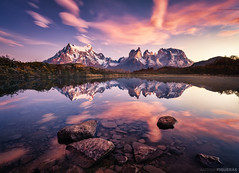Every August, the town of Bulacán commemorates two very important events: the feast day of its patron, Nuestra Señora de la Asunción on the 15th (which is today!), and; the birth anniversary of the anti-friar Propagandista Movement, Marcelo H. del Pilar. Stark contrast: two events with contrasting ideologies commemorated on the same month.

Monument of General Gregorio del Pilar. Not many Filipinos know that Goyo was a nephew of Marcelo H. del Pilar.

Cupang Bridge. Cupang was the small barrio where Marcelo del Pilar was born. It is now a part of Barrio Maysantol.
When me and Yeyette visited the town of Bulacán a few weeks back (07/25/2011), we had Lola Bening in mind. It was to fulfill a promise that we will visit her grandfather’s shrine soon. Unfortunately, when we got there, we found out that the Marcelo H. del Pilar shrine is closed on Mondays (just like when we visited the Apolinario Mabini Shrine. Guess we’ll have to visit again.
The municipality of Bulacán —sharing the name of the Tagalog-speaking province where it is located— is one of the provincial towns that is very near Metro Manila. It can be reached, in fact, in just an hour from the City of Manila via the Municipality of Obando — but only if traffic is cooperative. When we went there, however, we rode a bus that passed through world-class North Luzón Expressway since we’re not accustomed to trips north of Manila (the Southerners that we are). We dropped off at Bigaá (now Balagtás) then rode a jeepney going straight to Bulacán.
According to sources, the town’s name was derived from the Tagalog word bulac which means “cotton” which apparently used to grow abundantly in the area. But Bulacán today does not cultivate cotton; farming, fishing, garments, and food processing are its major industries today. What I am still unsure of is whether this town was named after the province, or if the province was named after the town. But surely, Bulacán is one of the country’s oldest; it was founded by the Augustinian Order in 1572, just a year after the country was founded by the Spaniards. In fact, its church, Nuestra Señora De La Asunción, is the province’s oldest. But the stone structure and convent was built in 1762, the same year when the British invaded Manila. From there, the invaders went to as far as Bulacán and burned the church. Fray Gaspar Folgar had the church repaired in 1812. But it was damaged again by the deadly Corpus Christi earthquake of 1863. Another earthquake in 1869 tilted the belfry, but Fray Marcos Hernández renovated it in 1877. Restoration work was done by Fray Patricio Martín in 1885; it was completed by Fray Domingo de la Prieta in 1889.

The church's original flooring, exposed via an excavation, can be viewed on the right side of the church's main entrance.

My wife has become freakish for ancient bricks (the red-colored ones slightly covered by a modern finish).

Romanesque design of corbeled arches underneath the raking cornice. The upper part of the square pillar is designed
Afterwards, it’s lunchtime at Sizzling World!
After lunch, we immediately resumed our walkathon.
Casa Delgado
After our lunch and some pan de sal, we walked a few more streets to look for more ancestral houses. Thankfully, we chanced upon this beautiful architectural gem…
It was obvious from the outside that the house is already abandoned. But we had to make sure. Yeyette asked around for confirmation. The house actually was “semi-abandoned”. Nobody lives there anymore but it is still owned by one Jack Rodrigo who just lives a few paces from the house. After receiving directions, we set for his house.
He’s a gentleman who appears to be in his late 40s. Yeyette introduced ourselves and told him that we’re bahay na bató aficionados, and that we just want to take photos of the house’s interiors. The kind sir, however, prohibited us from going inside the house due to “paranormal” reasons.
In the past, Mr. Rodrigo said that he allowed his ancestral house to be photographed from within. Some movie companies have also rented it. In fact, scenes from the classic Pancho Magalona film Luis Látigo were shot inside that house. However, he started receiving reports that people who go inside the house to take pictures and film movies have noticed strange things happening to them. Bad luck and other unfortunate incidents followed them home. Some of them got sick. The more unfortunate ones were even possessed (assumedly by evil spirits).
It sent shivers up my wife’s spine; I took it all in stride. But when Mr. Rodrigo mentioned that he reported these strange occurences to the local priest, I have to admit that it got into me somehow. If the Church is involved, then this has got to be serious and not just mere “tacután” talk from people who are fans of urban legends and creepy stories. Mr. Rodrigo himself has not gone inside that house —the very house where he grew up— since his college years.
He said that the house had been blessed once or twice, but nothing happened. The hauntings continued, especially when the house is disturbed by tourists. I asked Mr. Rodrigo for the name of the house (Filipino houses usually bear the last name of the family who owns it). The name is Casa Delgado, the family on his mother’s side.
The name Delgado rang a bell. I asked him if it was the home of Francisco Delgado, and he confirmed it.
“Yes, it is the ancestral house of former Senator Francisco Delgado, my great grandfather. The house was built in 1886. Senator Delgado was also a cousin of former Philippine Ambassador to the Vatican,” informed Mr. Rodrigo.
Senator? Cousin? Something was wrong….
“I’m also related to another senator…”
“Yes, I think I know,” I butted in, remembering his surname. “Senator Francisco ‘Soc’ Rodrigo.” Wifey was impressed. She then proceeded to tell Mr. Rodrigo that I’m a historian. I should have corrected her: I’m no historian, just a history buff. I got no PhDs or MAs.
In the end, Mr. Rodrigo allowed us to go through the gate to take pictures of his great grandfather’s ancestral house.

Since we were not allowed to go inside, I just took a photo of the interiors from the window beside the main entrance. My camera caught nothing eerie.

The grass around the house was very high, and snakes abound. The place is impassable without the proper tools to ward of the grass and the snakes.
*******
On our way home, I kept on thinking about that conversation we had with Mr. Rodrigo. There was something amiss. Francisco Delgado? Senator?
I did some research online and in my library. And then it hit me.
The Delgado I had in mind was not Francisco Delgado, after all. It was José Mª Delgado. I got both persons all mixed-up in my mind. Francisco Delgado y Afán was a Resident Commissioner 2 to the 74th United States Congress during the American Occupation of the Philippines from 1935 to 1937. He was a Freemason. On the other hand, his cousin, José Mª Delgado, was a soldier of God: he was the first Filipino to be appointed ambassador to the Vatican. The Freemason senator is from Bulacán town; the Christian cousin is from Malolos.
Cousins with different ideologies: one Freemason, the other, Christian. Another stark contrast.
Is the late senator’s affiliation with Freemasonry the reason why his house remains uninviting and unsafe to mortals?
*******
The people we talked with were hospitable, and even invited us back for the town fiesta. To bad we couldn’t be there today. Anyways, happy fiesta, Bulacán!













































































Nice and interesting post Pepe. Fortunately too the parish seems to be history conscious. The town seems inviting and homey.
LikeLike
To know more about this historic town, its culture and people, please visit “Mga Laki sa Bulakan Bulacan” or “Bulakan, Bulacan” fan pages in Facebook. Thank you.
LikeLike
Pingback: Charming Chavacano! (Ciudad de Cavite, Cavite) « FILIPINO eSCRIBBLES
Nice blog. I especially like the part about the Delgado House (I once studied in the small private school beside it). I’m from this town and I’m glad to see that the our humble but historic town is still appreciated by those from other places. Thanks for featuring our town in your blog! Come back soon! 🙂
LikeLike
Hi! Wonderful account. Thanks for sharing to the public. My great-grandfather is Francisco A. Delgado’s brother, and we have been wondering about their house in Bulacan. Would you happen to have Mr. Rodrigo’s contact information? Or may I have at least the address of and directions to Casa Delgado? Would be thrilled to see finally see it. =)
LikeLike
tnx for having this couple of shots of my cousins house, yes his son is my cousin,im in charge of documenting ancestral houses of bulakan, and the only area that im off to is in this house, im afraid getting involve with the ghost ..im cristopher rodrigo im documenting it for my thesis, as for my final year in architecture…. but u guys misses enriquez house and soc rodrigos mansion.. that why i’ll go by my self taking photos of them..
LikeLike
Nice thing there’s an article about casa rodrigo. Thanks to you sir! And I actually grew up there in Bulakan. GodBless!
LikeLike
I’m a direct descendant of the Delgados who own this house. Jack Rodrigo, too. But he’s a bit confused. He’s my nephew, being the son of my first cousin. I Guess the couple who took the pictures must be descendants of ka Bening Santos. This house was bought by our great grandfather, Jacinto Ycasiano from Tabacalera and was given as a gift to our grandmother, Juana Ycasiano, married to Ambrosio Delgado. Senator Francisco Delgado was his younger brother. Another “Bahay na bato”, in Bo. San Jose of the same province was also given as a gift to a younger daughter, Josefa Ycasiano Enriquez, who is the mother-in-law of Senator Francisco “Soc” Rodrigo. Pepe and Yvette should also see that house! Bulakan really boasts of being a province of beautiful women, national heroes and verdant fields. That was what I used to see on a poster which welcomed visitors to Bulakan as I was growing up. My family and I would love to meet Pepe and Yvette to share thoughts and memories of our beloved Bulakan, Bulakan.
LikeLike
Thank you so much! Sure, just let us know when. By the way, it’s Yeyette, not Yvette. 😀
Best regards!
LikeLike
May I know the exact address of Casa Rodrigo please? Thank you!
LikeLike
May I Ask your permission so We can use it for our project we will leave some credits
LikeLike